Implementing Electronic Permit to Work System in Oman Oil Refinery
VerifiedAdded on 2023/03/23
|21
|3915
|25
Project
AI Summary
This project focuses on the implementation of an Electronic Permit to Work System for the Oman Oil Refinery and Petroleum Industries Company (Orpic). It covers the project's introduction and objectives, highlighting Orpic's business context and the importance of electronic permits for managing hazardous activities. The project outlines the roles of the project team, including the company owner, project manager, research team, and electronic permit providers. Key project stages, such as initiation, data collection, analysis, and dissemination of findings, are detailed along with key deliverables. The project plan includes a work breakdown structure (WBS), activity list, Gantt chart, and network diagram. A risk register and quality plan are also presented, addressing potential issues and ensuring the successful implementation of the electronic permit system within Orpic to enhance safety and operational efficiency.

Running head: ELECTRONIC PERMIT TO WORK SYSTEM
Electronic Permit to Work System for Oman Oil Refinery and Petroleum Industries Company
Name of the Student
Name of the University
Author note
Electronic Permit to Work System for Oman Oil Refinery and Petroleum Industries Company
Name of the Student
Name of the University
Author note
Paraphrase This Document
Need a fresh take? Get an instant paraphrase of this document with our AI Paraphraser
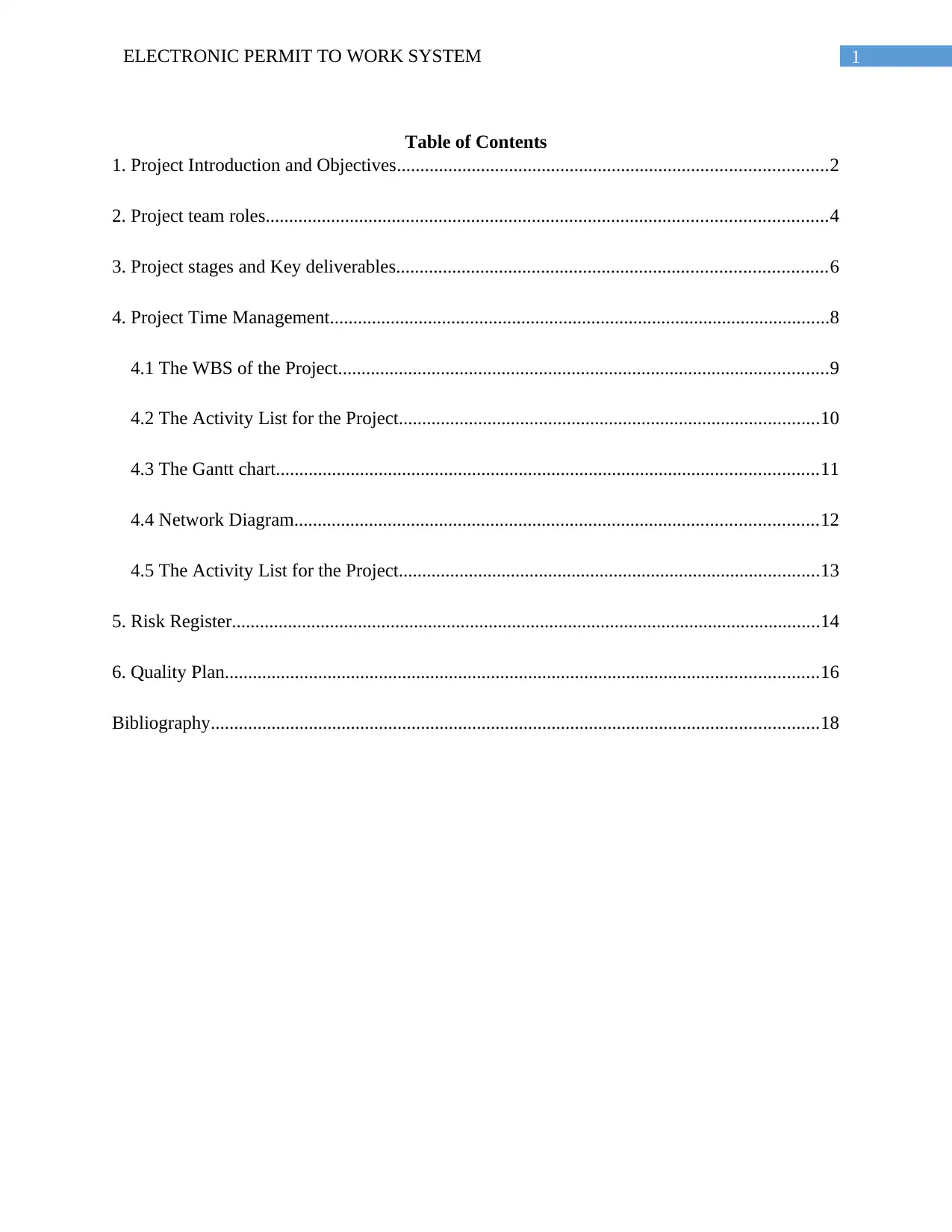
1ELECTRONIC PERMIT TO WORK SYSTEM
Table of Contents
1. Project Introduction and Objectives............................................................................................2
2. Project team roles........................................................................................................................4
3. Project stages and Key deliverables............................................................................................6
4. Project Time Management...........................................................................................................8
4.1 The WBS of the Project.........................................................................................................9
4.2 The Activity List for the Project..........................................................................................10
4.3 The Gantt chart....................................................................................................................11
4.4 Network Diagram................................................................................................................12
4.5 The Activity List for the Project..........................................................................................13
5. Risk Register..............................................................................................................................14
6. Quality Plan...............................................................................................................................16
Bibliography..................................................................................................................................18
Table of Contents
1. Project Introduction and Objectives............................................................................................2
2. Project team roles........................................................................................................................4
3. Project stages and Key deliverables............................................................................................6
4. Project Time Management...........................................................................................................8
4.1 The WBS of the Project.........................................................................................................9
4.2 The Activity List for the Project..........................................................................................10
4.3 The Gantt chart....................................................................................................................11
4.4 Network Diagram................................................................................................................12
4.5 The Activity List for the Project..........................................................................................13
5. Risk Register..............................................................................................................................14
6. Quality Plan...............................................................................................................................16
Bibliography..................................................................................................................................18
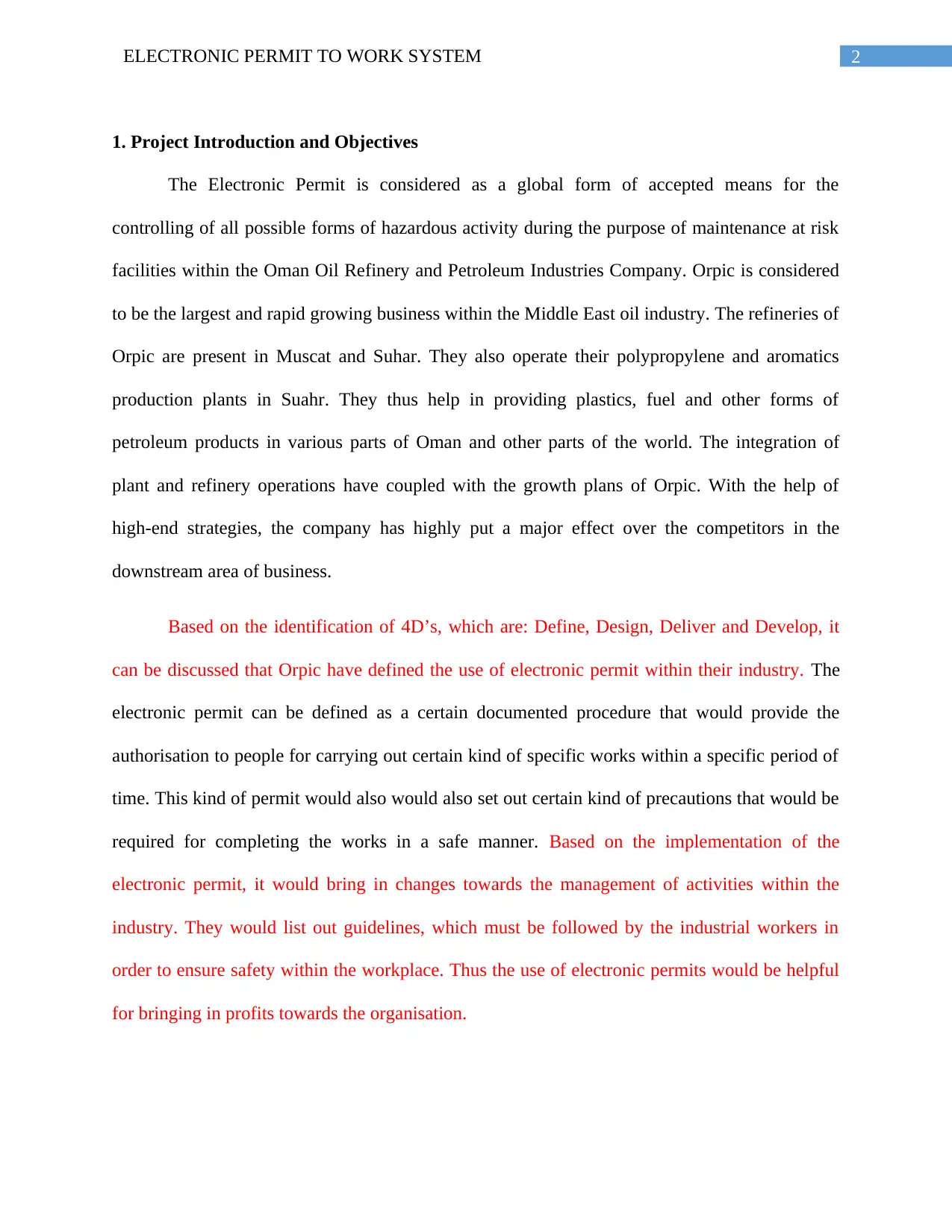
2ELECTRONIC PERMIT TO WORK SYSTEM
1. Project Introduction and Objectives
The Electronic Permit is considered as a global form of accepted means for the
controlling of all possible forms of hazardous activity during the purpose of maintenance at risk
facilities within the Oman Oil Refinery and Petroleum Industries Company. Orpic is considered
to be the largest and rapid growing business within the Middle East oil industry. The refineries of
Orpic are present in Muscat and Suhar. They also operate their polypropylene and aromatics
production plants in Suahr. They thus help in providing plastics, fuel and other forms of
petroleum products in various parts of Oman and other parts of the world. The integration of
plant and refinery operations have coupled with the growth plans of Orpic. With the help of
high-end strategies, the company has highly put a major effect over the competitors in the
downstream area of business.
Based on the identification of 4D’s, which are: Define, Design, Deliver and Develop, it
can be discussed that Orpic have defined the use of electronic permit within their industry. The
electronic permit can be defined as a certain documented procedure that would provide the
authorisation to people for carrying out certain kind of specific works within a specific period of
time. This kind of permit would also would also set out certain kind of precautions that would be
required for completing the works in a safe manner. Based on the implementation of the
electronic permit, it would bring in changes towards the management of activities within the
industry. They would list out guidelines, which must be followed by the industrial workers in
order to ensure safety within the workplace. Thus the use of electronic permits would be helpful
for bringing in profits towards the organisation.
1. Project Introduction and Objectives
The Electronic Permit is considered as a global form of accepted means for the
controlling of all possible forms of hazardous activity during the purpose of maintenance at risk
facilities within the Oman Oil Refinery and Petroleum Industries Company. Orpic is considered
to be the largest and rapid growing business within the Middle East oil industry. The refineries of
Orpic are present in Muscat and Suhar. They also operate their polypropylene and aromatics
production plants in Suahr. They thus help in providing plastics, fuel and other forms of
petroleum products in various parts of Oman and other parts of the world. The integration of
plant and refinery operations have coupled with the growth plans of Orpic. With the help of
high-end strategies, the company has highly put a major effect over the competitors in the
downstream area of business.
Based on the identification of 4D’s, which are: Define, Design, Deliver and Develop, it
can be discussed that Orpic have defined the use of electronic permit within their industry. The
electronic permit can be defined as a certain documented procedure that would provide the
authorisation to people for carrying out certain kind of specific works within a specific period of
time. This kind of permit would also would also set out certain kind of precautions that would be
required for completing the works in a safe manner. Based on the implementation of the
electronic permit, it would bring in changes towards the management of activities within the
industry. They would list out guidelines, which must be followed by the industrial workers in
order to ensure safety within the workplace. Thus the use of electronic permits would be helpful
for bringing in profits towards the organisation.
⊘ This is a preview!⊘
Do you want full access?
Subscribe today to unlock all pages.

Trusted by 1+ million students worldwide
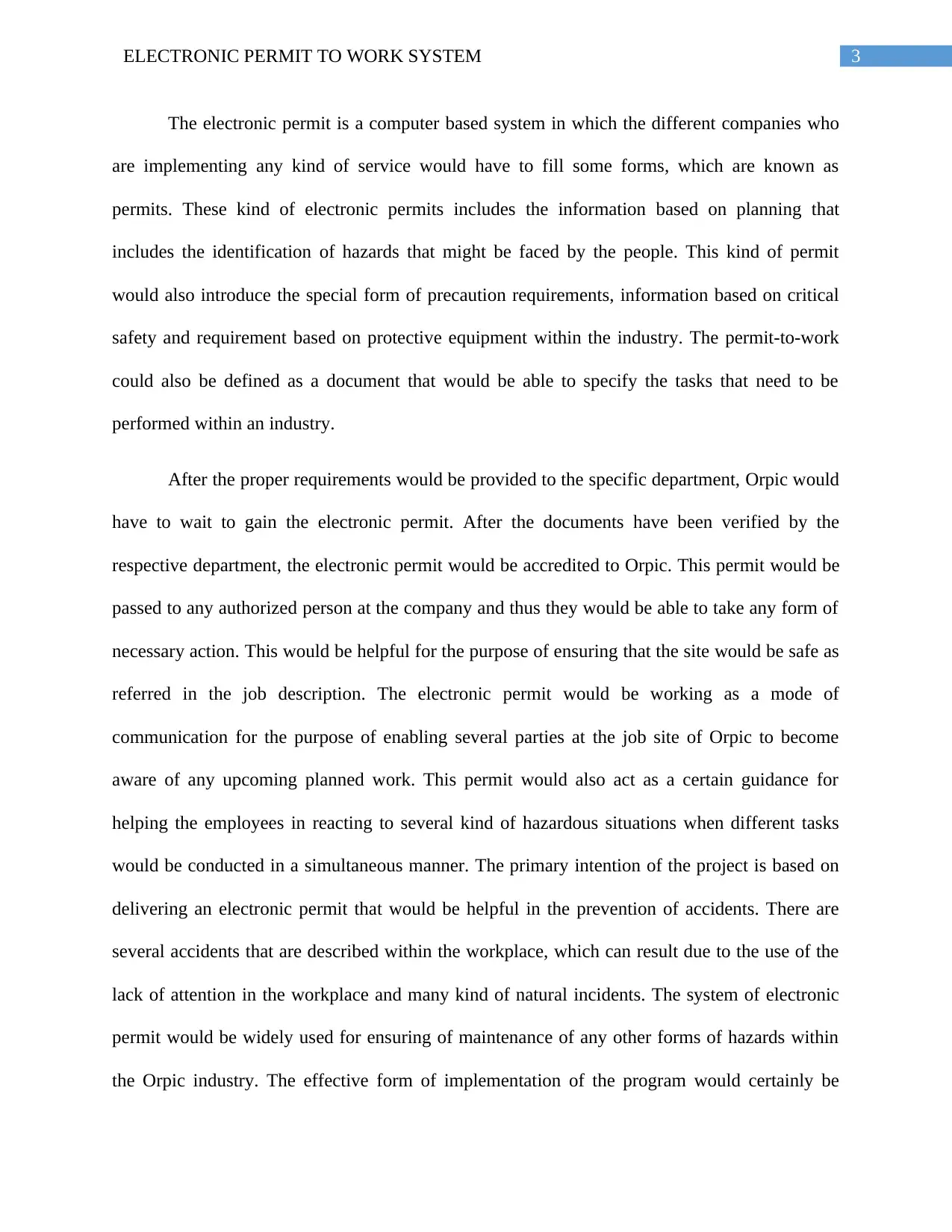
3ELECTRONIC PERMIT TO WORK SYSTEM
The electronic permit is a computer based system in which the different companies who
are implementing any kind of service would have to fill some forms, which are known as
permits. These kind of electronic permits includes the information based on planning that
includes the identification of hazards that might be faced by the people. This kind of permit
would also introduce the special form of precaution requirements, information based on critical
safety and requirement based on protective equipment within the industry. The permit-to-work
could also be defined as a document that would be able to specify the tasks that need to be
performed within an industry.
After the proper requirements would be provided to the specific department, Orpic would
have to wait to gain the electronic permit. After the documents have been verified by the
respective department, the electronic permit would be accredited to Orpic. This permit would be
passed to any authorized person at the company and thus they would be able to take any form of
necessary action. This would be helpful for the purpose of ensuring that the site would be safe as
referred in the job description. The electronic permit would be working as a mode of
communication for the purpose of enabling several parties at the job site of Orpic to become
aware of any upcoming planned work. This permit would also act as a certain guidance for
helping the employees in reacting to several kind of hazardous situations when different tasks
would be conducted in a simultaneous manner. The primary intention of the project is based on
delivering an electronic permit that would be helpful in the prevention of accidents. There are
several accidents that are described within the workplace, which can result due to the use of the
lack of attention in the workplace and many kind of natural incidents. The system of electronic
permit would be widely used for ensuring of maintenance of any other forms of hazards within
the Orpic industry. The effective form of implementation of the program would certainly be
The electronic permit is a computer based system in which the different companies who
are implementing any kind of service would have to fill some forms, which are known as
permits. These kind of electronic permits includes the information based on planning that
includes the identification of hazards that might be faced by the people. This kind of permit
would also introduce the special form of precaution requirements, information based on critical
safety and requirement based on protective equipment within the industry. The permit-to-work
could also be defined as a document that would be able to specify the tasks that need to be
performed within an industry.
After the proper requirements would be provided to the specific department, Orpic would
have to wait to gain the electronic permit. After the documents have been verified by the
respective department, the electronic permit would be accredited to Orpic. This permit would be
passed to any authorized person at the company and thus they would be able to take any form of
necessary action. This would be helpful for the purpose of ensuring that the site would be safe as
referred in the job description. The electronic permit would be working as a mode of
communication for the purpose of enabling several parties at the job site of Orpic to become
aware of any upcoming planned work. This permit would also act as a certain guidance for
helping the employees in reacting to several kind of hazardous situations when different tasks
would be conducted in a simultaneous manner. The primary intention of the project is based on
delivering an electronic permit that would be helpful in the prevention of accidents. There are
several accidents that are described within the workplace, which can result due to the use of the
lack of attention in the workplace and many kind of natural incidents. The system of electronic
permit would be widely used for ensuring of maintenance of any other forms of hazards within
the Orpic industry. The effective form of implementation of the program would certainly be
Paraphrase This Document
Need a fresh take? Get an instant paraphrase of this document with our AI Paraphraser
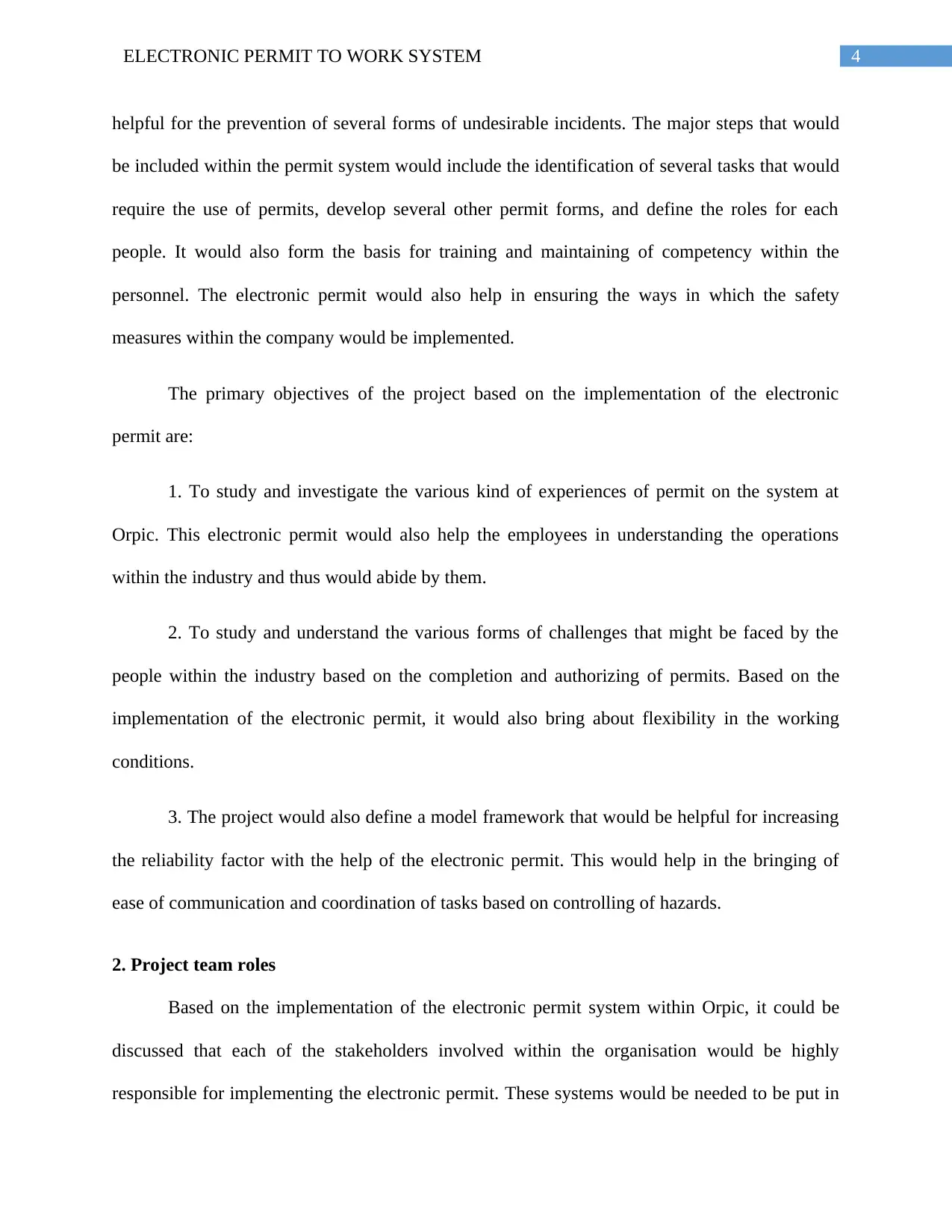
4ELECTRONIC PERMIT TO WORK SYSTEM
helpful for the prevention of several forms of undesirable incidents. The major steps that would
be included within the permit system would include the identification of several tasks that would
require the use of permits, develop several other permit forms, and define the roles for each
people. It would also form the basis for training and maintaining of competency within the
personnel. The electronic permit would also help in ensuring the ways in which the safety
measures within the company would be implemented.
The primary objectives of the project based on the implementation of the electronic
permit are:
1. To study and investigate the various kind of experiences of permit on the system at
Orpic. This electronic permit would also help the employees in understanding the operations
within the industry and thus would abide by them.
2. To study and understand the various forms of challenges that might be faced by the
people within the industry based on the completion and authorizing of permits. Based on the
implementation of the electronic permit, it would also bring about flexibility in the working
conditions.
3. The project would also define a model framework that would be helpful for increasing
the reliability factor with the help of the electronic permit. This would help in the bringing of
ease of communication and coordination of tasks based on controlling of hazards.
2. Project team roles
Based on the implementation of the electronic permit system within Orpic, it could be
discussed that each of the stakeholders involved within the organisation would be highly
responsible for implementing the electronic permit. These systems would be needed to be put in
helpful for the prevention of several forms of undesirable incidents. The major steps that would
be included within the permit system would include the identification of several tasks that would
require the use of permits, develop several other permit forms, and define the roles for each
people. It would also form the basis for training and maintaining of competency within the
personnel. The electronic permit would also help in ensuring the ways in which the safety
measures within the company would be implemented.
The primary objectives of the project based on the implementation of the electronic
permit are:
1. To study and investigate the various kind of experiences of permit on the system at
Orpic. This electronic permit would also help the employees in understanding the operations
within the industry and thus would abide by them.
2. To study and understand the various forms of challenges that might be faced by the
people within the industry based on the completion and authorizing of permits. Based on the
implementation of the electronic permit, it would also bring about flexibility in the working
conditions.
3. The project would also define a model framework that would be helpful for increasing
the reliability factor with the help of the electronic permit. This would help in the bringing of
ease of communication and coordination of tasks based on controlling of hazards.
2. Project team roles
Based on the implementation of the electronic permit system within Orpic, it could be
discussed that each of the stakeholders involved within the organisation would be highly
responsible for implementing the electronic permit. These systems would be needed to be put in
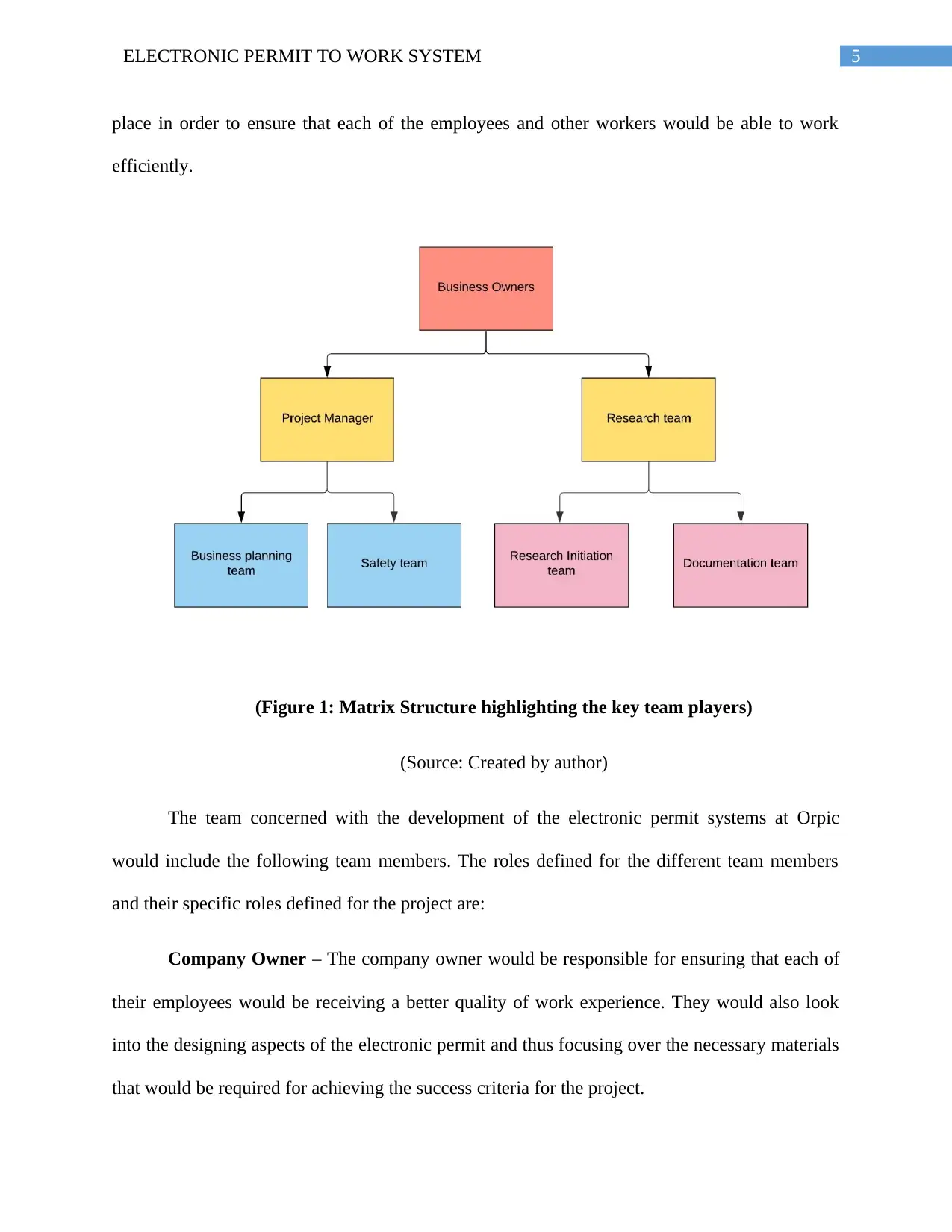
5ELECTRONIC PERMIT TO WORK SYSTEM
place in order to ensure that each of the employees and other workers would be able to work
efficiently.
(Figure 1: Matrix Structure highlighting the key team players)
(Source: Created by author)
The team concerned with the development of the electronic permit systems at Orpic
would include the following team members. The roles defined for the different team members
and their specific roles defined for the project are:
Company Owner – The company owner would be responsible for ensuring that each of
their employees would be receiving a better quality of work experience. They would also look
into the designing aspects of the electronic permit and thus focusing over the necessary materials
that would be required for achieving the success criteria for the project.
place in order to ensure that each of the employees and other workers would be able to work
efficiently.
(Figure 1: Matrix Structure highlighting the key team players)
(Source: Created by author)
The team concerned with the development of the electronic permit systems at Orpic
would include the following team members. The roles defined for the different team members
and their specific roles defined for the project are:
Company Owner – The company owner would be responsible for ensuring that each of
their employees would be receiving a better quality of work experience. They would also look
into the designing aspects of the electronic permit and thus focusing over the necessary materials
that would be required for achieving the success criteria for the project.
⊘ This is a preview!⊘
Do you want full access?
Subscribe today to unlock all pages.

Trusted by 1+ million students worldwide
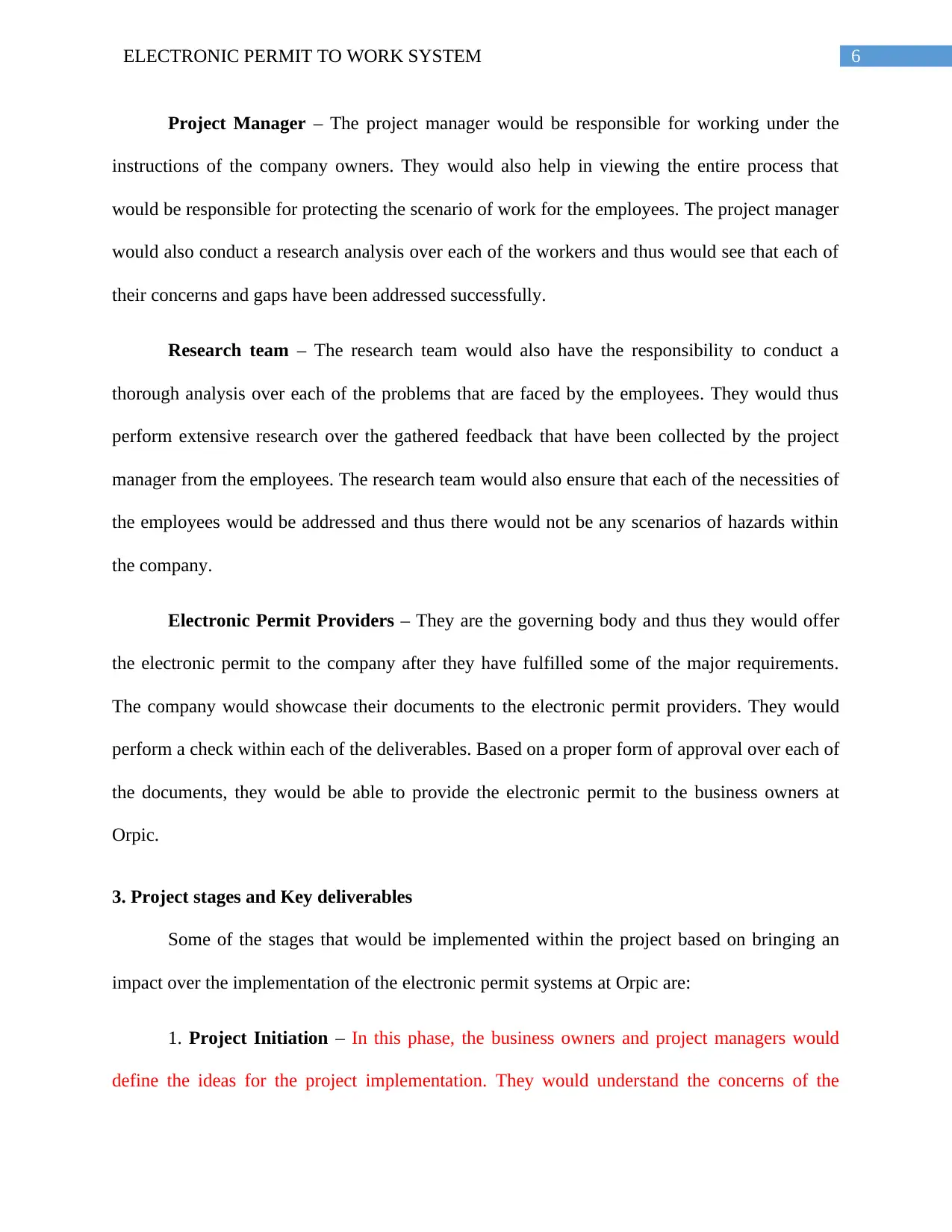
6ELECTRONIC PERMIT TO WORK SYSTEM
Project Manager – The project manager would be responsible for working under the
instructions of the company owners. They would also help in viewing the entire process that
would be responsible for protecting the scenario of work for the employees. The project manager
would also conduct a research analysis over each of the workers and thus would see that each of
their concerns and gaps have been addressed successfully.
Research team – The research team would also have the responsibility to conduct a
thorough analysis over each of the problems that are faced by the employees. They would thus
perform extensive research over the gathered feedback that have been collected by the project
manager from the employees. The research team would also ensure that each of the necessities of
the employees would be addressed and thus there would not be any scenarios of hazards within
the company.
Electronic Permit Providers – They are the governing body and thus they would offer
the electronic permit to the company after they have fulfilled some of the major requirements.
The company would showcase their documents to the electronic permit providers. They would
perform a check within each of the deliverables. Based on a proper form of approval over each of
the documents, they would be able to provide the electronic permit to the business owners at
Orpic.
3. Project stages and Key deliverables
Some of the stages that would be implemented within the project based on bringing an
impact over the implementation of the electronic permit systems at Orpic are:
1. Project Initiation – In this phase, the business owners and project managers would
define the ideas for the project implementation. They would understand the concerns of the
Project Manager – The project manager would be responsible for working under the
instructions of the company owners. They would also help in viewing the entire process that
would be responsible for protecting the scenario of work for the employees. The project manager
would also conduct a research analysis over each of the workers and thus would see that each of
their concerns and gaps have been addressed successfully.
Research team – The research team would also have the responsibility to conduct a
thorough analysis over each of the problems that are faced by the employees. They would thus
perform extensive research over the gathered feedback that have been collected by the project
manager from the employees. The research team would also ensure that each of the necessities of
the employees would be addressed and thus there would not be any scenarios of hazards within
the company.
Electronic Permit Providers – They are the governing body and thus they would offer
the electronic permit to the company after they have fulfilled some of the major requirements.
The company would showcase their documents to the electronic permit providers. They would
perform a check within each of the deliverables. Based on a proper form of approval over each of
the documents, they would be able to provide the electronic permit to the business owners at
Orpic.
3. Project stages and Key deliverables
Some of the stages that would be implemented within the project based on bringing an
impact over the implementation of the electronic permit systems at Orpic are:
1. Project Initiation – In this phase, the business owners and project managers would
define the ideas for the project implementation. They would understand the concerns of the
Paraphrase This Document
Need a fresh take? Get an instant paraphrase of this document with our AI Paraphraser
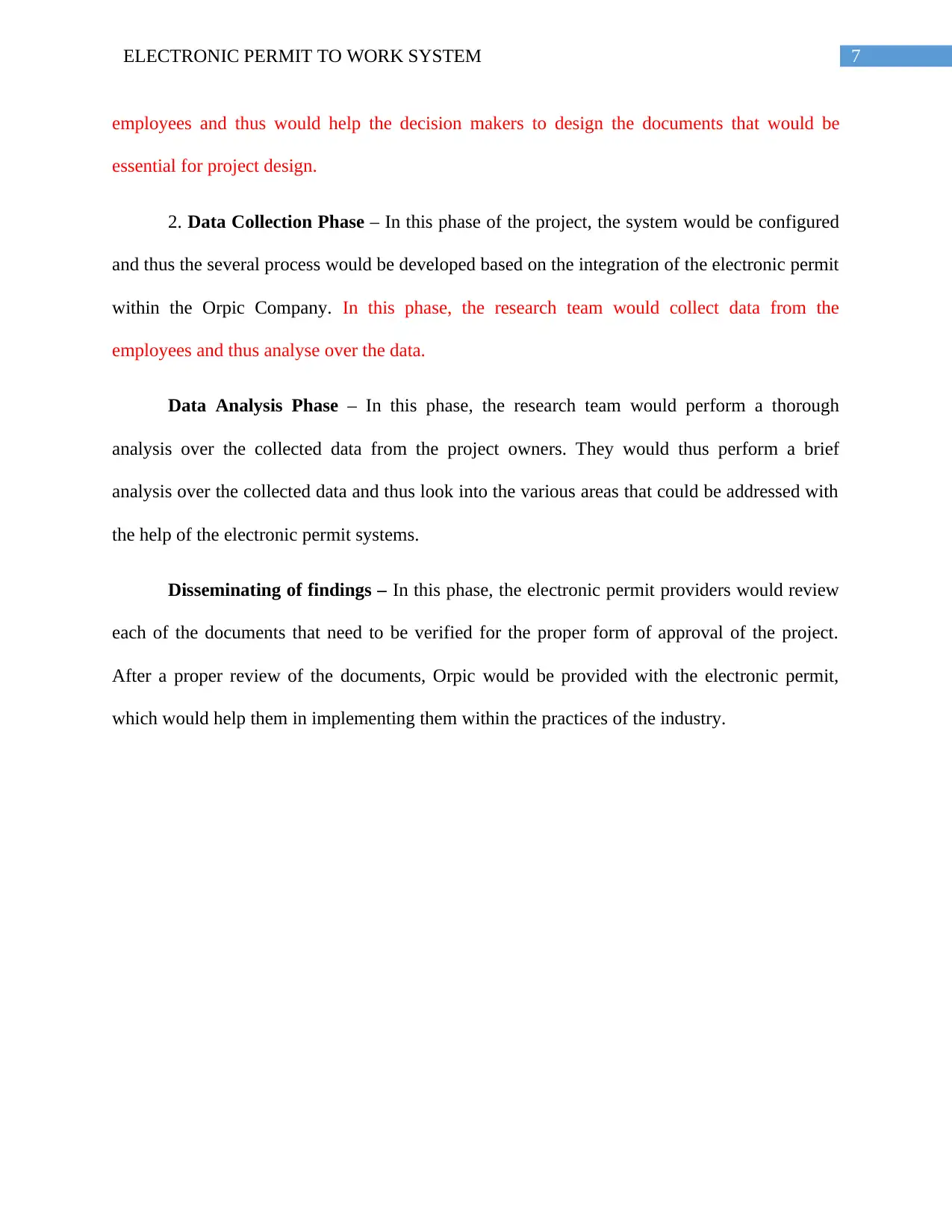
7ELECTRONIC PERMIT TO WORK SYSTEM
employees and thus would help the decision makers to design the documents that would be
essential for project design.
2. Data Collection Phase – In this phase of the project, the system would be configured
and thus the several process would be developed based on the integration of the electronic permit
within the Orpic Company. In this phase, the research team would collect data from the
employees and thus analyse over the data.
Data Analysis Phase – In this phase, the research team would perform a thorough
analysis over the collected data from the project owners. They would thus perform a brief
analysis over the collected data and thus look into the various areas that could be addressed with
the help of the electronic permit systems.
Disseminating of findings – In this phase, the electronic permit providers would review
each of the documents that need to be verified for the proper form of approval of the project.
After a proper review of the documents, Orpic would be provided with the electronic permit,
which would help them in implementing them within the practices of the industry.
employees and thus would help the decision makers to design the documents that would be
essential for project design.
2. Data Collection Phase – In this phase of the project, the system would be configured
and thus the several process would be developed based on the integration of the electronic permit
within the Orpic Company. In this phase, the research team would collect data from the
employees and thus analyse over the data.
Data Analysis Phase – In this phase, the research team would perform a thorough
analysis over the collected data from the project owners. They would thus perform a brief
analysis over the collected data and thus look into the various areas that could be addressed with
the help of the electronic permit systems.
Disseminating of findings – In this phase, the electronic permit providers would review
each of the documents that need to be verified for the proper form of approval of the project.
After a proper review of the documents, Orpic would be provided with the electronic permit,
which would help them in implementing them within the practices of the industry.

8ELECTRONIC PERMIT TO WORK SYSTEM
4. Project Time Management
4. Project Time Management
⊘ This is a preview!⊘
Do you want full access?
Subscribe today to unlock all pages.

Trusted by 1+ million students worldwide
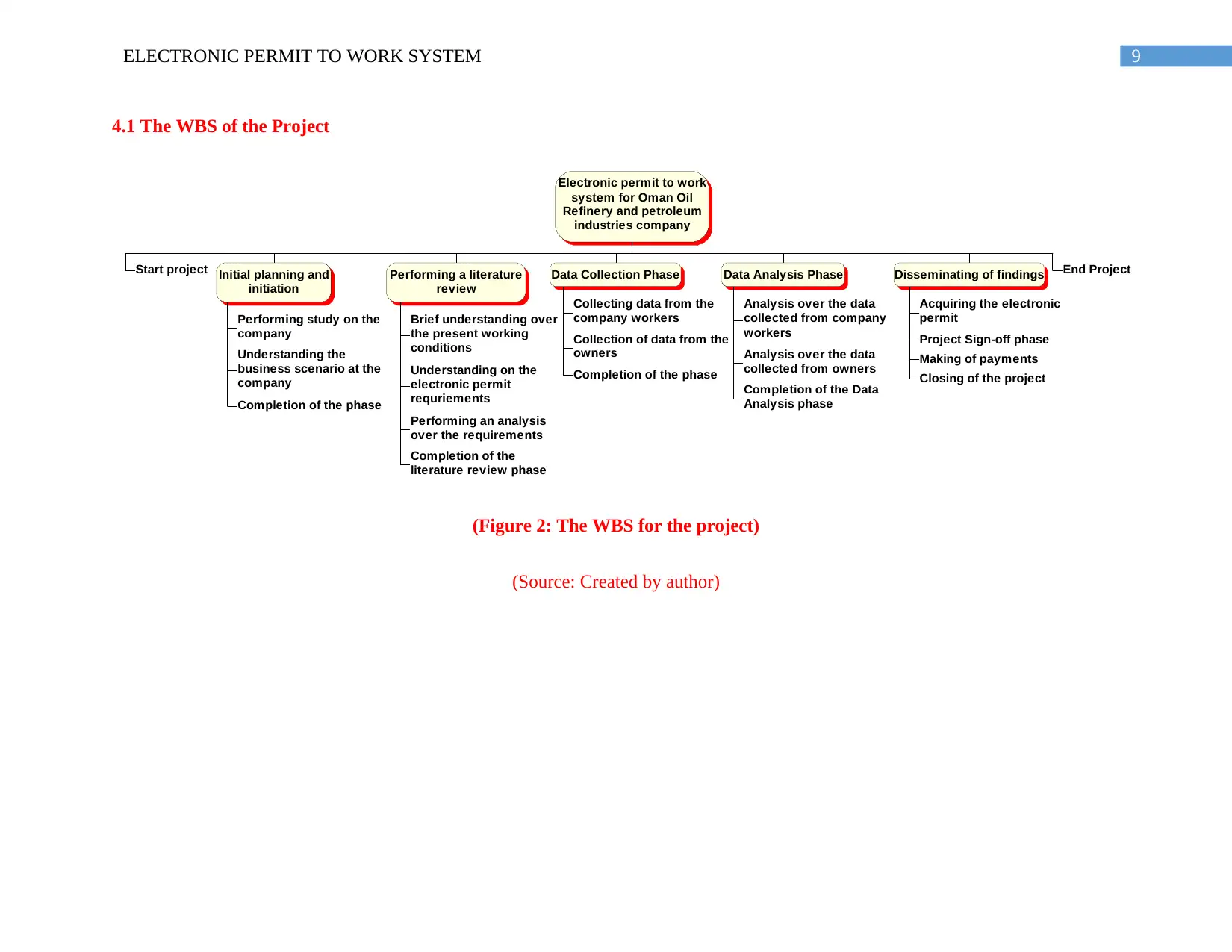
9ELECTRONIC PERMIT TO WORK SYSTEM
4.1 The WBS of the Project
Electronic permit to work
system for Oman Oil
Refinery and petroleum
industries company
Start project Initial planning and
initiation
Performing study on the
company
Understanding the
business scenario at the
company
Completion of the phase
Performing a literature
review
Brief understanding over
the present working
conditions
Understanding on the
electronic permit
requriements
Performing an analysis
over the requirements
Completion of the
literature review phase
Data Collection Phase
Collecting data from the
company workers
Collection of data from the
owners
Completion of the phase
Data Analysis Phase
Analysis over the data
collected from company
workers
Analysis over the data
collected from owners
Completion of the Data
Analysis phase
Disseminating of findings
Acquiring the electronic
permit
Project Sign-off phase
Making of payments
Closing of the project
End Project
(Figure 2: The WBS for the project)
(Source: Created by author)
4.1 The WBS of the Project
Electronic permit to work
system for Oman Oil
Refinery and petroleum
industries company
Start project Initial planning and
initiation
Performing study on the
company
Understanding the
business scenario at the
company
Completion of the phase
Performing a literature
review
Brief understanding over
the present working
conditions
Understanding on the
electronic permit
requriements
Performing an analysis
over the requirements
Completion of the
literature review phase
Data Collection Phase
Collecting data from the
company workers
Collection of data from the
owners
Completion of the phase
Data Analysis Phase
Analysis over the data
collected from company
workers
Analysis over the data
collected from owners
Completion of the Data
Analysis phase
Disseminating of findings
Acquiring the electronic
permit
Project Sign-off phase
Making of payments
Closing of the project
End Project
(Figure 2: The WBS for the project)
(Source: Created by author)
Paraphrase This Document
Need a fresh take? Get an instant paraphrase of this document with our AI Paraphraser
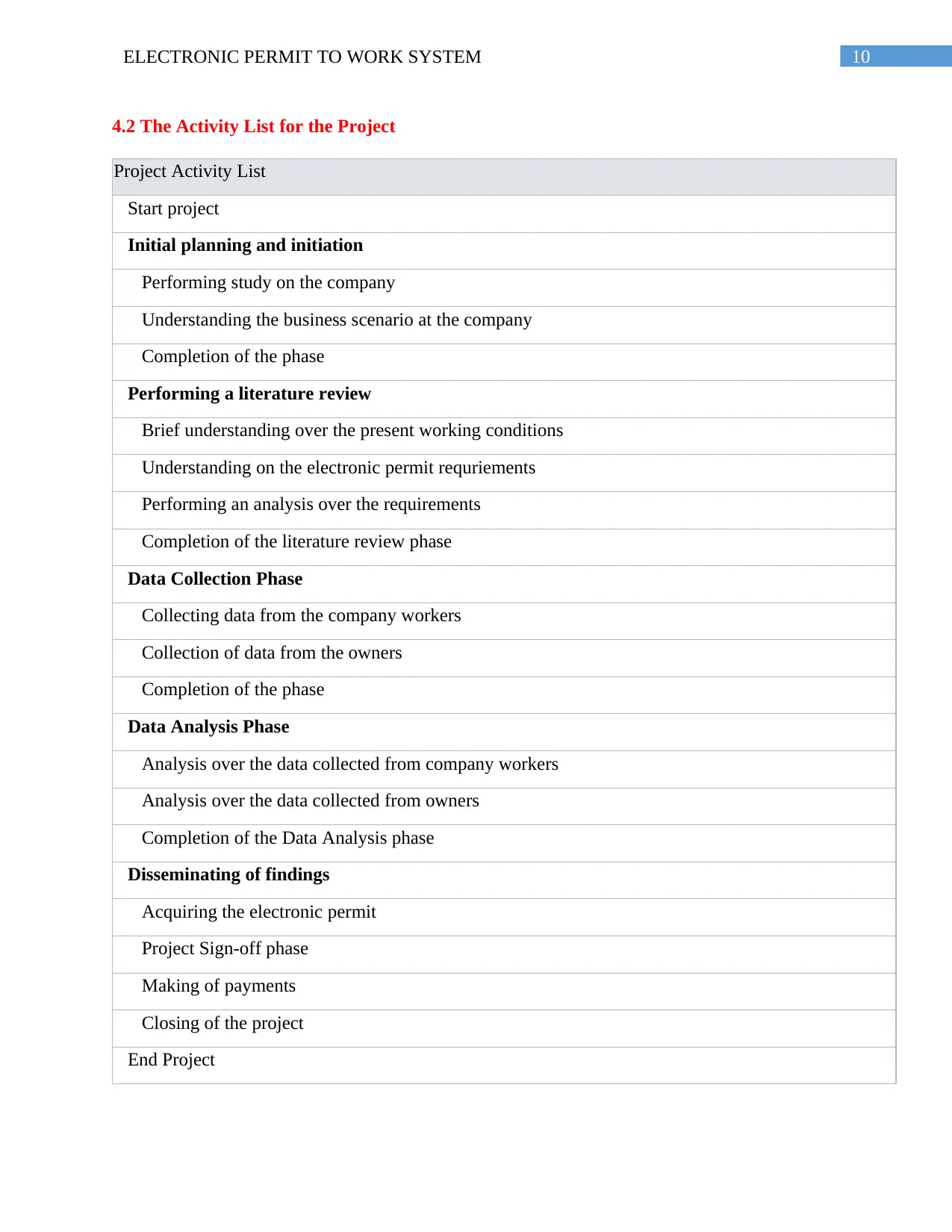
10ELECTRONIC PERMIT TO WORK SYSTEM
4.2 The Activity List for the Project
Project Activity List
Start project
Initial planning and initiation
Performing study on the company
Understanding the business scenario at the company
Completion of the phase
Performing a literature review
Brief understanding over the present working conditions
Understanding on the electronic permit requriements
Performing an analysis over the requirements
Completion of the literature review phase
Data Collection Phase
Collecting data from the company workers
Collection of data from the owners
Completion of the phase
Data Analysis Phase
Analysis over the data collected from company workers
Analysis over the data collected from owners
Completion of the Data Analysis phase
Disseminating of findings
Acquiring the electronic permit
Project Sign-off phase
Making of payments
Closing of the project
End Project
4.2 The Activity List for the Project
Project Activity List
Start project
Initial planning and initiation
Performing study on the company
Understanding the business scenario at the company
Completion of the phase
Performing a literature review
Brief understanding over the present working conditions
Understanding on the electronic permit requriements
Performing an analysis over the requirements
Completion of the literature review phase
Data Collection Phase
Collecting data from the company workers
Collection of data from the owners
Completion of the phase
Data Analysis Phase
Analysis over the data collected from company workers
Analysis over the data collected from owners
Completion of the Data Analysis phase
Disseminating of findings
Acquiring the electronic permit
Project Sign-off phase
Making of payments
Closing of the project
End Project
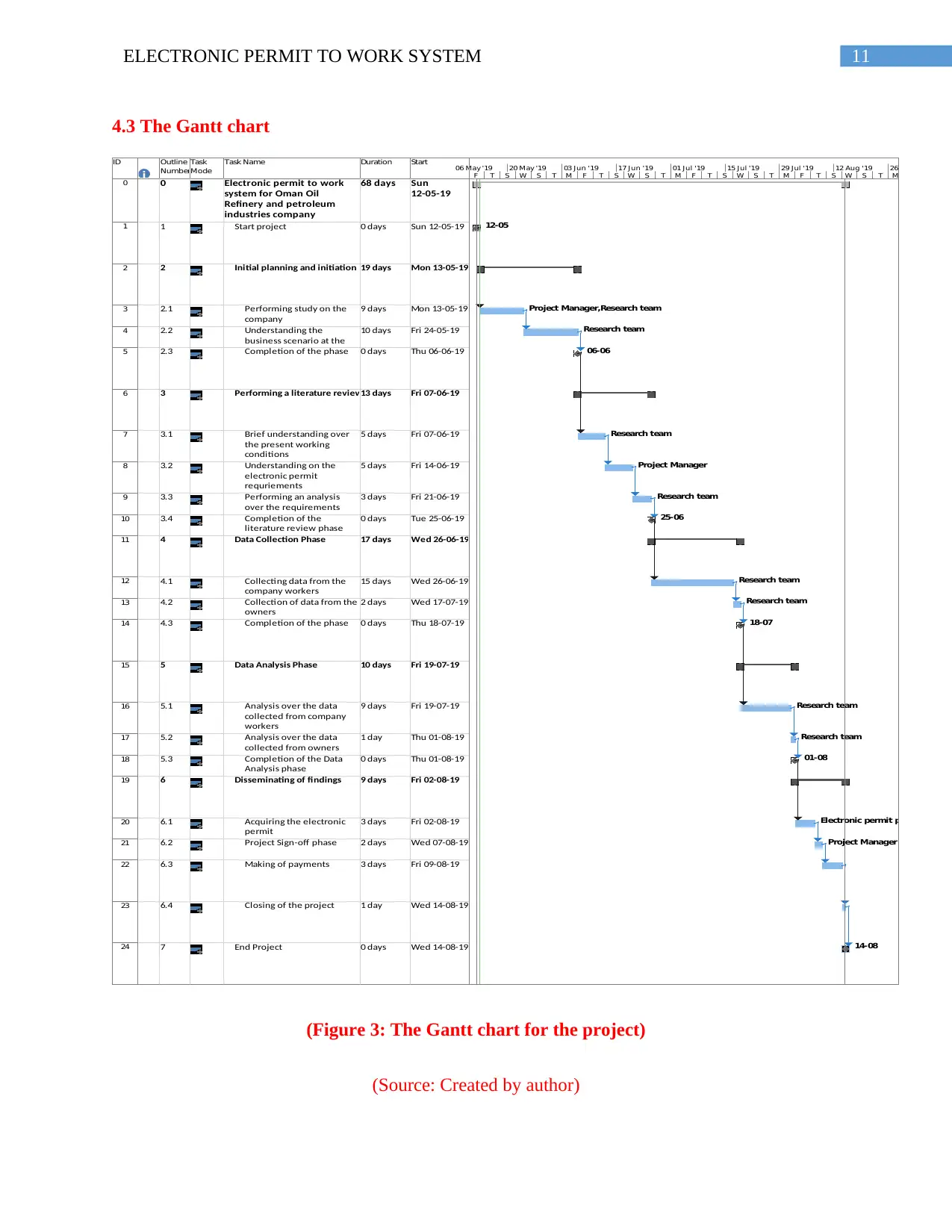
11ELECTRONIC PERMIT TO WORK SYSTEM
4.3 The Gantt chart
ID Outline
Number
Task
Mode
Task Name Duration Start
0 0 Electronic permit to work
system for Oman Oil
Refinery and petroleum
industries company
68 days Sun
12-05-19
1 1 Start project 0 days Sun 12-05-19
2 2 Initial planning and initiation 19 days Mon 13-05-19
3 2.1 Performing study on the
company
9 days Mon 13-05-19
4 2.2 Understanding the
business scenario at the
company
10 days Fri 24-05-19
5 2.3 Completion of the phase 0 days Thu 06-06-19
6 3 Performing a literature review13 days Fri 07-06-19
7 3.1 Brief understanding over
the present working
conditions
5 days Fri 07-06-19
8 3.2 Understanding on the
electronic permit
requriements
5 days Fri 14-06-19
9 3.3 Performing an analysis
over the requirements
3 days Fri 21-06-19
10 3.4 Completion of the
literature review phase
0 days Tue 25-06-19
11 4 Data Collection Phase 17 days Wed 26-06-19
12 4.1 Collecting data from the
company workers
15 days Wed 26-06-19
13 4.2 Collection of data from the
owners
2 days Wed 17-07-19
14 4.3 Completion of the phase 0 days Thu 18-07-19
15 5 Data Analysis Phase 10 days Fri 19-07-19
16 5.1 Analysis over the data
collected from company
workers
9 days Fri 19-07-19
17 5.2 Analysis over the data
collected from owners
1 day Thu 01-08-19
18 5.3 Completion of the Data
Analysis phase
0 days Thu 01-08-19
19 6 Disseminating of findings 9 days Fri 02-08-19
20 6.1 Acquiring the electronic
permit
3 days Fri 02-08-19
21 6.2 Project Sign-off phase 2 days Wed 07-08-19
22 6.3 Making of payments 3 days Fri 09-08-19
23 6.4 Closing of the project 1 day Wed 14-08-19
24 7 End Project 0 days Wed 14-08-19
12-05
Project Manager,Research team
Research team
06-06
Research team
Project Manager
Research team
25-06
Research team
Research team
18-07
Research team
Research team
01-08
Electronic permit providers
Project Manager
14-08
F T S W S T M F T S W S T M F T S W S T M F T S W S T M
06 May '19 20 May '19 03 Jun '19 17 Jun '19 01 Jul '19 15 Jul '19 29 Jul '19 12 Aug '19 26 Aug '19
(Figure 3: The Gantt chart for the project)
(Source: Created by author)
4.3 The Gantt chart
ID Outline
Number
Task
Mode
Task Name Duration Start
0 0 Electronic permit to work
system for Oman Oil
Refinery and petroleum
industries company
68 days Sun
12-05-19
1 1 Start project 0 days Sun 12-05-19
2 2 Initial planning and initiation 19 days Mon 13-05-19
3 2.1 Performing study on the
company
9 days Mon 13-05-19
4 2.2 Understanding the
business scenario at the
company
10 days Fri 24-05-19
5 2.3 Completion of the phase 0 days Thu 06-06-19
6 3 Performing a literature review13 days Fri 07-06-19
7 3.1 Brief understanding over
the present working
conditions
5 days Fri 07-06-19
8 3.2 Understanding on the
electronic permit
requriements
5 days Fri 14-06-19
9 3.3 Performing an analysis
over the requirements
3 days Fri 21-06-19
10 3.4 Completion of the
literature review phase
0 days Tue 25-06-19
11 4 Data Collection Phase 17 days Wed 26-06-19
12 4.1 Collecting data from the
company workers
15 days Wed 26-06-19
13 4.2 Collection of data from the
owners
2 days Wed 17-07-19
14 4.3 Completion of the phase 0 days Thu 18-07-19
15 5 Data Analysis Phase 10 days Fri 19-07-19
16 5.1 Analysis over the data
collected from company
workers
9 days Fri 19-07-19
17 5.2 Analysis over the data
collected from owners
1 day Thu 01-08-19
18 5.3 Completion of the Data
Analysis phase
0 days Thu 01-08-19
19 6 Disseminating of findings 9 days Fri 02-08-19
20 6.1 Acquiring the electronic
permit
3 days Fri 02-08-19
21 6.2 Project Sign-off phase 2 days Wed 07-08-19
22 6.3 Making of payments 3 days Fri 09-08-19
23 6.4 Closing of the project 1 day Wed 14-08-19
24 7 End Project 0 days Wed 14-08-19
12-05
Project Manager,Research team
Research team
06-06
Research team
Project Manager
Research team
25-06
Research team
Research team
18-07
Research team
Research team
01-08
Electronic permit providers
Project Manager
14-08
F T S W S T M F T S W S T M F T S W S T M F T S W S T M
06 May '19 20 May '19 03 Jun '19 17 Jun '19 01 Jul '19 15 Jul '19 29 Jul '19 12 Aug '19 26 Aug '19
(Figure 3: The Gantt chart for the project)
(Source: Created by author)
⊘ This is a preview!⊘
Do you want full access?
Subscribe today to unlock all pages.

Trusted by 1+ million students worldwide
1 out of 21
Related Documents
Your All-in-One AI-Powered Toolkit for Academic Success.
+13062052269
info@desklib.com
Available 24*7 on WhatsApp / Email
![[object Object]](/_next/static/media/star-bottom.7253800d.svg)
Unlock your academic potential
Copyright © 2020–2025 A2Z Services. All Rights Reserved. Developed and managed by ZUCOL.





